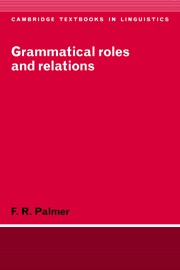Book contents
- Frontmatter
- Contents
- Acknowledgements
- Notation and abbrevations
- 1 Introduction
- 2 Roles and relations
- 3 Accusative, ergative and agentive systems
- 4 Syntactic relation
- 5 Passive
- 6 Passive: related and problematic issues
- 7 Antipassive
- 8 Topic and inverse systems
- 9 Causatives
- Glossary of terms
- References and citation index
- Language index
- General index
4 - Syntactic relation
Published online by Cambridge University Press: 05 June 2012
- Frontmatter
- Contents
- Acknowledgements
- Notation and abbrevations
- 1 Introduction
- 2 Roles and relations
- 3 Accusative, ergative and agentive systems
- 4 Syntactic relation
- 5 Passive
- 6 Passive: related and problematic issues
- 7 Antipassive
- 8 Topic and inverse systems
- 9 Causatives
- Glossary of terms
- References and citation index
- Language index
- General index
Summary
This chapter investigates in much more detail issues of syntax raised briefly in 1.3.1 and 3.1.
Syntactic pivots
Some of the grammatical relations, particularly the Subject in accusative languages, are involved in certain grammatical constructions. Thus, in English, if two sentences are coordinated, usually with and, the subject of the second is normally omitted or ‘deleted’, if it is coreferential with that of the first, as in (with the omitted NP shown in brackets):
The man came in. The man saw the woman.
The man came in and [the man] saw the woman.
This is only possible if both nouns are Subjects, as can be seen from the impossible sentences:
The man came in. The woman saw the man.
*The man came in and the woman saw [the man].
The man saw the woman. The woman came.
*The man saw the woman and [the woman] came in.
The man saw the woman. The boy heard the woman.
*The man saw the woman and the boy heard [the woman].
This restriction on deletion in coordination, together with similar syntactic conditions that are dealt with in more detail in later sections of this chapter, is treated in terms of ‘pivot’, the Subject being said to be the pivot for deletion in coordination in English. However, two NPs are involved in the coreferentiality and it may be better to refer to both of them as ‘pivots’, the first being the ‘controller’ and the second the ‘target’ (Foley and Van Valin 1985: 305), though in much of the discussion the term is used to refer to the second, the target.
- Type
- Chapter
- Information
- Grammatical Roles and Relations , pp. 88 - 116Publisher: Cambridge University PressPrint publication year: 1994



